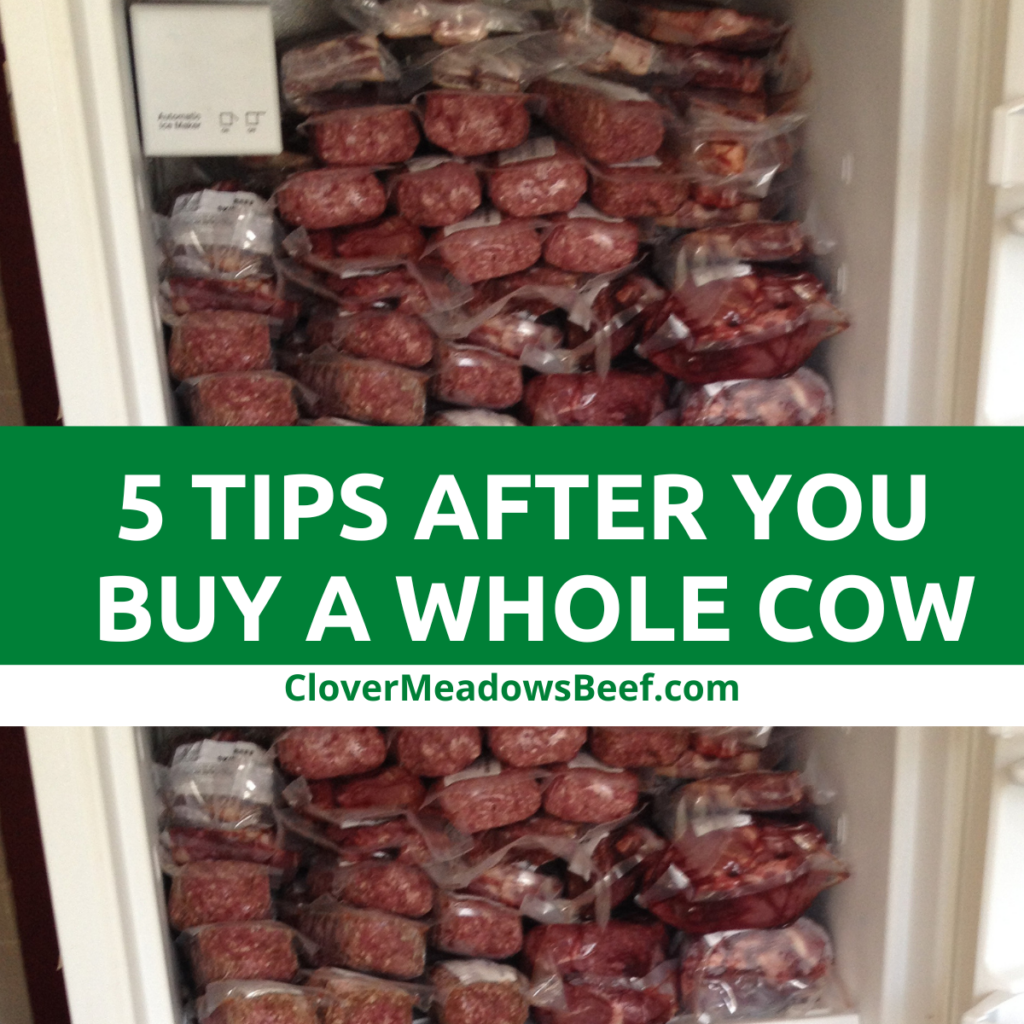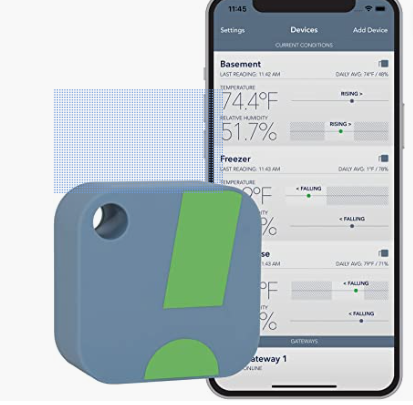It’s exciting to buy a whole cow, but what do you do once you make the purchase? A whole cow is a lot of beef and you need to be prepared for your beef before you put it in your freezer. Here’s what you need to know and do after you buy a cow.

Do you want to buy a whole cow? Perhaps, you’ve already purchased it and now you’re waiting for beef pick-up. Whether you’ve already made the purchase or you’re still researching, buying beef directly from a farm or ranch is a smart thing to do. When you buy a whole cow (or half or quarter), you will save money on beef and you will have a freezer full of beef ready to go for you and your family.
If you’re still researching whether or not to buy a whole cow, check out our guide on How to Buy a Cow from a Farmer, Questions to Ask Before Buying a Side of Beef, Understanding Cuts of Beef: What Comes with a Quarter, Half Beef, and video on Buying Half a Cow: How Much Beef is it Really? We talk extensively about the questions to ask before buying a cow, and those posts answer questions like…
- Will I really save money buying beef in bulk as a whole cow? half beef? quarter beef?
- How can I find a local farmer or rancher in my area?
- What’s better grass-fed beef or grain finished cattle?
- What’s the difference between live weight, cut weight and hanging weight?
- What individual cuts of meat come when you buy a cow — filet mignon? short ribs? chuck roast? brisket? stew meat? t-bones? tongue? liver? oxtail?
- Should the beef be USDA inspected? State inspected?
The 5 tips below are for anyone that has bought a cow, and is preparing to have a freezer full of beef. Here’s what you need to know and do:
1. Get a Freezer When You Buy a Whole Cow
Whether you buy a whole cow, a half cow, or a quarter cow, you will need a stand-alone freezer for your beef. How much freezer space you need depends on the amount of beef you purchse.
The general rule of thumb is that it takes one cubic foot of freezer space for every 30-35 pounds of packaged meat. Plus, you should allow slightly more space when packages are in odd shapes, like soup bones.
The following freezer sizes are recommended for a whole beef, half beef, and quarter beef:
- Whole Cow (approximately 440 lbs packaged beef): 19 cubic feet freezer recommended for storage
- Half Cow (approximately 220 lbs packaged beef): 8 cubic feet freezer recommended for storage
- Quarter Cow (approximately 110 lbs packaged beef): 5 cubic feet freezer recommended for storage
We currently own an upright freezer and chest freezer. We prefer our upright freezer because it holds more, it’s much easier to organize, and we don’t have to “dig” through it like our chest freezers. However, an upright freezer is also more expensive.
Whatever type you get, be sure to get one that has a lock built into it. The lock helps the freezer door close properly so the food won’t spoil inside. You can also purchase an aftermarket lock.
Beef packaging varies by processor. Vacuum sealed beef will last approximateily 1-year in a freezer.
2. Get a Freezer Alarm When You Buy a Whole Cow
We can’t say enough good things about a freezer alarm. We first learned about freezer alarms after we lost a freezer full of beef due to a blown circuit breaker we weren’t aware of. Losing a freezer full of beef is extremely expensive, and beyond frustrating.
Since most people have their freezer in their basement or garage, they don’t see the freezer everyday and may not know if it’s not working correctly. In our situation, if we had a freezer alarm, we could have saved the beef before it thawed and became unsafe to eat.
A Freezer Alarm notifies you if your freezer is at the incorrect temperature so that you can respond appropriately, before the meat goes bad. Our freezer alarm comes with a smartphone app and WiFi connectivity, which allows us to constantly monitor the temperature of our freezer from anywhere at any time. It also sends alerts to our smartphones if the temperature reaches a dangerous level.
This is the freezer alarm we have.

3. Get Organized When You Buy a Whole Cow
When you buy a whole cow, you get approximateily 440 lbs of beef — that’s a LOT of beef. This can be very overwhelming. You could just put the beef in the freezer in a haphazard way, but you’ll regret it if you do. There are lots of ways to organize beef, but here’s how we do it:
- Group beef together by cut. Put all ground beef together, all steaks together, all roasts together, etc.
- Use freezer shelfs and additional storage bins, as needed. If you have an upright freezer, use the shelfs and doors to help separate beef into categories. For steaks, use storage bins to help keep similar steaks grouped together. If you have a chest freezer, use storage bins to organize the beef. Group beef together by cut in the chest freezer. For example, all ground beef is on the right side of the freezer and steaks are on the left side.
- Follow the first-in, first out rule. If you already have beef in the freezer, be sure to follow the first-in, first-out rule. Keep the oldest beef more visible in front so that you’ll use it first.
4. Put a Date on the Beef
Before you put anything into your freezer you should date it — this applies to homemade freezer meals or a whole cow.
Often times, beef from a processor has the date it was processed on the label. If the beef label doesn’t have the date, use a Sharpie and write the month and year the beef was processed on each package.
When you organize the beef in your freezer (step 3), be sure to follow the first-in, first-out rule and keep the oldest beef on the top of your freezer so that you eat it first. Otherwise, the oldest beef ends up at the bottom or back of the freezer, and may not be discovered until after it has freezer burn. Ideally, you want to eat the oldest beef first and avoid food waste.
5. Make a Freezer Inventory Log
A freezer inventory sheet is a helpful log that keeps tabs of what’s in your freezer. There are numerous ways to make a freezer inventory log.
We like to keep it simple with a magnetic white board on the front of our freezer. An even simpilier method is to just write on the freezer with a dry erase marker (without the board). You can also download free paper inventory logs online.
One More Thing
Do you want to learn more about beef? Below are a few popular beef posts and recipes you may like. In addition, we have an entire ebook about beef that goes through purchasing and preparing beef from a farmers perspective.
- Is It Done Yet? The Best Meat Thermometer
- Defrosting Meat: 4 Safe & Easy Ways
- Beef Liver Cubes: How to Hide Liver in Food
- Understanding Cuts of Beef: What Comes with a Quarter Beef, Half Beef
- Slow Cooker Pepper Steak
- Prime Rib Roast with Garlic Herb Butter
We have a weekly e-newsletter where we share about farm happenings, when our next beef availability is, and all things beef. When you sign-up, you’ll get a cheat sheet with 9-must-ask questions before buying beef directly from a farmer.
We participate in the Amazon Services LLC Associates Program, an affiliate advertising program designed to provide a means for us to earn fees by linking to Amazon.com and affiliated sites. See our disclosure policy for more details.

